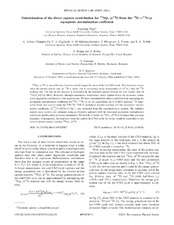| dc.creator | Tang, XD | |
| dc.creator | Azhari, A. | |
| dc.creator | Fu, CB | |
| dc.creator | Gagliardi, Carl A. | |
| dc.creator | Mukhamedzhanov, AM | |
| dc.creator | Pirlepesov, F. | |
| dc.creator | Trache, L. | |
| dc.creator | Tribble, Robert E. | |
| dc.creator | Burjan, V. | |
| dc.creator | Kroha, V. | |
| dc.creator | Carstoiu, F. | |
| dc.creator | Irgaziev, BF. | |
| dc.date.accessioned | 2011-09-13T21:27:18Z | |
| dc.date.available | 2011-09-13T21:27:18Z | |
| dc.date.issued | 2004 | |
| dc.identifier.citation | XD Tang, A. Azhari, CB Fu, Carl A. Gagliardi, A. M. Mukhamedzhanov, F. Pirlepesov, L. Trache, Robert E. Tribble, V. Burjan, V. Kroha, F. Carstoiu and B. F. Irgaziev. Phys.Rev.C 69 055807 2004. "Copyright (2004) by the American Physical Society." | en |
| dc.identifier.uri | http://dx.doi.org/10.1103/PhysRevC.69.055807 | |
| dc.identifier.uri | https://hdl.handle.net/1969.1/126963 | |
| dc.description | Journals published by the American Physical Society can be found at http://publish.aps.org/ | en |
| dc.description.abstract | N-13(p, gamma)O-14 is one of the key reactions which trigger the onset of the hot CNO cycle. This transition occurs when the proton capture rate on 13N is faster, due to increasing stellar temperature (greater than or equal to10(9) K), than the N-13 beta-decay rate. The rate of this reaction is dominated by the resonant capture through the first excited state of O-14 (E-r=0.528 MeV). However, through constructive interference, direct capture below the resonance makes a non-negligible contribution to the reaction rate. We have determined this direct contribution by measuring the asymptotic normalization coefficient for O-14 --> N-13+p. In our experiment, an 11.8 MeV/nucleon N-13 radioactive beam was used to study the N-14(N-13, O-14)C-13 peripheral transfer reaction, and the asymptotic normalization coefficient, (C-p1/2(14O))(2)=29.0+/-4.3 fm(-1), was extracted from the measured cross section. The radiative capture cross section was estimated using an R-matrix approach with the measured asymptotic normalization coefficient and the latest resonance parameters. We find the S factor for N-13(p, gamma)O-14 to be larger than previous estimates. Consequently, the transition from the cold to hot CNO cycle for novae would be controlled by the slowest proton capture reaction N-14(p, gamma)O-15. | en |
| dc.language.iso | en | |
| dc.publisher | American Physical Society | |
| dc.subject | COUPLED-CHANNELS CALCULATIONS | en |
| dc.subject | CROSS-SECTION | en |
| dc.subject | LOW ENERGIES | en |
| dc.subject | Physics | en |
| dc.title | Determination of the direct capture contribution for N-13(p,gamma)O-14 from the O-14 -> N-13+p asymptotic normalization coefficient | en |
| dc.type | Article | en |
| local.department | Physics and Astronomy | en |


